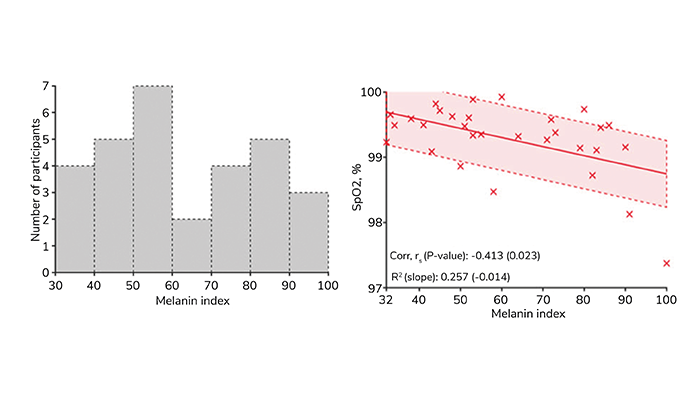According to research from Carnegie Mellon University, USA, skin melanin concentration significantly impacts the signal quality of frequency-domain near-infrared spectroscopy (FD-NIRS) – highlighting the need for adjustments in the technology to improve its accuracy across diverse populations.
FD-NIRS works by emitting light in the near-infrared range (690–830 nm) through tissue and measuring the intensity of the reflected light. This technique is sensitive to changes in tissue oxygenation but is also affected by melanin, which absorbs light in the same range, particularly at the shorter wavelengths.

To investigate how melanin affects the accuracy of near-infrared spectroscopy (NIRS) measurements, researchers correlated the melanin levels of 35 adults with a diverse range of skin tones, measured using a colorimeter (left), with key NIRS outputs. Notably, SpO2 exhibited a significant negative correlation (p = 0.023) with the melanin index (right).
The study examined 35 healthy adults with varying melanin levels. Using a colorimeter to measure melanin concentration, the research team evaluated how melanin affected key metrics in NIRS measurements, including SNR, arterial oxygen saturation (SpO2), tissue oxygenation (StO2), and optical properties such as the absorption coefficient. The data revealed that, though SNR and SpO2 decreased as melanin levels increased, StO2 and optical properties remained largely unaffected.
A particularly notable finding was the wavelength-dependent behavior of melanin. The study showed that light at 690 nm experienced a more significant reduction in SNR compared with light at 830 nm, with a correlation coefficient of -0.568 for 690 nm versus -0.28 for 830 nm. This highlights the importance of wavelength selection in NIRS measurements for individuals with darker skin tones. “As melanin concentration increases, the light absorption at 690 nm intensifies, leading to a loss in signal quality," the authors noted.
The research also explored the implications of these findings for clinical applications, particularly in the measurement of arterial oxygen saturation (SpO2). A negative correlation was observed between SpO2 and melanin concentration, suggesting that NIRS could underestimate oxygen saturation in individuals with darker skin. However, tissue oxygenation (StO2) remained unaffected by melanin concentration, offering some reliability in measuring oxygenation despite pigmentation differences.
To mitigate the impact of melanin, the study recommends considering adjustments in NIRS device design, such as optimizing the light source for longer wavelengths and calibrating devices for a wider range of skin tones. These changes could help improve the accuracy and generalizability of NIRS measurements in diverse populations. "The inclusion of melanin concentration data in NIRS studies is crucial for ensuring that these devices provide accurate and reliable results for all individuals, regardless of skin tone," the authors emphasized.
Image credit: S. Roy et al., doi 10.1117/1.JBO.29.S3.S33310




